登録情報 データベース : PDB / ID : 6zp1タイトル Structure of SARS-CoV-2 Spike Protein Trimer (K986P, V987P, single Arg S1/S2 cleavage site) in Closed State Spike glycoprotein キーワード / / / / / / / / / 機能・相同性 分子機能 ドメイン・相同性 構成要素
/ / / / / / / / / / / / / / / / / / / / / / / / / / / / / / / / / / / / / / / / / / / / / / / / / / / / / / / / / / / / / / / / / / / / / / / 生物種 手法 / / / 解像度 : 3.3 Å データ登録者 Xiong, X. / Qu, K. / Scheres, S.H.W. / Briggs, J.A.G. 資金援助 組織 認可番号 国 Medical Research Council (MRC, United Kingdom) MC_UP_1201/16 European Research Council (ERC) ERC-CoG-648432 European Union German Research Foundation (DFG) 240245660 - SFB1129 Medical Research Council (MRC, United Kingdom) MC_UP_A025_1013
ジャーナル : Nat Struct Mol Biol / 年 : 2020タイトル : A thermostable, closed SARS-CoV-2 spike protein trimer.著者: Xiaoli Xiong / Kun Qu / Katarzyna A Ciazynska / Myra Hosmillo / Andrew P Carter / Soraya Ebrahimi / Zunlong Ke / Sjors H W Scheres / Laura Bergamaschi / Guinevere L Grice / Ying Zhang / / ... 著者 : Xiaoli Xiong / Kun Qu / Katarzyna A Ciazynska / Myra Hosmillo / Andrew P Carter / Soraya Ebrahimi / Zunlong Ke / Sjors H W Scheres / Laura Bergamaschi / Guinevere L Grice / Ying Zhang / / James A Nathan / Stephen Baker / Leo C James / Helen E Baxendale / Ian Goodfellow / Rainer Doffinger / John A G Briggs / 要旨 : The spike (S) protein of SARS-CoV-2 mediates receptor binding and cell entry and is the dominant target of the immune system. It exhibits substantial conformational flexibility. It transitions from ... The spike (S) protein of SARS-CoV-2 mediates receptor binding and cell entry and is the dominant target of the immune system. It exhibits substantial conformational flexibility. It transitions from closed to open conformations to expose its receptor-binding site and, subsequently, from prefusion to postfusion conformations to mediate fusion of viral and cellular membranes. S-protein derivatives are components of vaccine candidates and diagnostic assays, as well as tools for research into the biology and immunology of SARS-CoV-2. Here we have designed mutations in S that allow the production of thermostable, disulfide-bonded S-protein trimers that are trapped in the closed, prefusion state. Structures of the disulfide-stabilized and non-disulfide-stabilized proteins reveal distinct closed and locked conformations of the S trimer. We demonstrate that the designed, thermostable, closed S trimer can be used in serological assays. This protein has potential applications as a reagent for serology, virology and as an immunogen. 履歴 登録 2020年7月8日 登録サイト / 処理サイト 改定 1.0 2020年7月22日 Provider / タイプ 改定 2.0 2020年7月29日 Group Atomic model / Data collection ... Atomic model / Data collection / Derived calculations / Structure summary カテゴリ atom_site / chem_comp ... atom_site / chem_comp / entity / pdbx_branch_scheme / pdbx_chem_comp_identifier / pdbx_entity_branch / pdbx_entity_branch_descriptor / pdbx_entity_branch_link / pdbx_entity_branch_list / pdbx_entity_nonpoly / pdbx_nonpoly_scheme / pdbx_struct_assembly_gen / struct_asym / struct_conn / struct_site / struct_site_gen Item _atom_site.B_iso_or_equiv / _atom_site.Cartn_x ... _atom_site.B_iso_or_equiv / _atom_site.Cartn_x / _atom_site.Cartn_y / _atom_site.Cartn_z / _atom_site.auth_asym_id / _atom_site.auth_seq_id / _atom_site.label_asym_id / _atom_site.label_entity_id / _chem_comp.name / _pdbx_entity_nonpoly.entity_id / _pdbx_entity_nonpoly.name / _pdbx_struct_assembly_gen.asym_id_list / _struct_conn.pdbx_role / _struct_conn.ptnr1_auth_asym_id / _struct_conn.ptnr1_auth_seq_id / _struct_conn.ptnr1_label_asym_id / _struct_conn.ptnr2_auth_asym_id / _struct_conn.ptnr2_auth_seq_id / _struct_conn.ptnr2_label_asym_id 解説 / Provider / タイプ 改定 2.1 2020年8月12日 Group / Structure summary / カテゴリ / citation / citation_authorItem _chem_comp.pdbx_synonyms / _citation.country ... _chem_comp.pdbx_synonyms / _citation.country / _citation.journal_abbrev / _citation.journal_id_CSD / _citation.journal_id_ISSN / _citation.pdbx_database_id_DOI / _citation.pdbx_database_id_PubMed / _citation.title / _citation.year 改定 2.2 2020年10月21日 Group / カテゴリ / citation_authorItem _citation.journal_volume / _citation.page_first ... _citation.journal_volume / _citation.page_first / _citation.page_last / _citation_author.identifier_ORCID 改定 2.3 2021年2月10日 Group / カテゴリ / Item 改定 3.0 2021年5月26日 Group Advisory / Atomic model ... Advisory / Atomic model / Database references / Derived calculations / Polymer sequence / Source and taxonomy / Structure summary カテゴリ atom_site / entity ... atom_site / entity / entity_poly / entity_poly_seq / entity_src_gen / pdbx_poly_seq_scheme / pdbx_struct_sheet_hbond / pdbx_unobs_or_zero_occ_residues / struct_conf / struct_conn / struct_ref_seq / struct_ref_seq_dif / struct_sheet_range Item _atom_site.label_seq_id / _entity.formula_weight ... _atom_site.label_seq_id / _entity.formula_weight / _entity_poly.pdbx_seq_one_letter_code / _entity_poly.pdbx_seq_one_letter_code_can / _entity_src_gen.pdbx_end_seq_num / _pdbx_struct_sheet_hbond.range_1_label_seq_id / _pdbx_struct_sheet_hbond.range_2_label_seq_id / _struct_conf.beg_label_seq_id / _struct_conf.end_label_seq_id / _struct_conn.ptnr1_label_seq_id / _struct_conn.ptnr2_label_seq_id / _struct_ref_seq.seq_align_end / _struct_sheet_range.beg_label_seq_id / _struct_sheet_range.end_label_seq_id 改定 4.0 2021年6月2日 Group Advisory / Atomic model ... Advisory / Atomic model / Data collection / Database references / Derived calculations / Structure summary カテゴリ atom_site / pdbx_poly_seq_scheme ... atom_site / pdbx_poly_seq_scheme / pdbx_struct_sheet_hbond / pdbx_unobs_or_zero_occ_residues / pdbx_validate_main_chain_plane / pdbx_validate_rmsd_angle / pdbx_validate_rmsd_bond / pdbx_validate_torsion / struct_conf / struct_conn / struct_ref_seq / struct_ref_seq_dif / struct_sheet_range Item _atom_site.auth_seq_id / _pdbx_poly_seq_scheme.pdb_seq_num ... _atom_site.auth_seq_id / _pdbx_poly_seq_scheme.pdb_seq_num / _pdbx_struct_sheet_hbond.range_1_auth_seq_id / _pdbx_struct_sheet_hbond.range_2_auth_seq_id / _pdbx_unobs_or_zero_occ_residues.auth_seq_id / _pdbx_validate_main_chain_plane.auth_seq_id / _pdbx_validate_rmsd_angle.auth_seq_id_1 / _pdbx_validate_rmsd_angle.auth_seq_id_2 / _pdbx_validate_rmsd_angle.auth_seq_id_3 / _pdbx_validate_rmsd_bond.auth_seq_id_1 / _pdbx_validate_rmsd_bond.auth_seq_id_2 / _pdbx_validate_torsion.auth_seq_id / _struct_conf.beg_auth_seq_id / _struct_conf.end_auth_seq_id / _struct_conn.ptnr1_auth_seq_id / _struct_conn.ptnr2_auth_seq_id / _struct_ref_seq.pdbx_auth_seq_align_end / _struct_ref_seq_dif.pdbx_auth_seq_num / _struct_sheet_range.beg_auth_seq_id / _struct_sheet_range.end_auth_seq_id 改定 4.1 2024年11月20日 Group Data collection / Database references ... Data collection / Database references / Refinement description / Structure summary カテゴリ chem_comp_atom / chem_comp_bond ... chem_comp_atom / chem_comp_bond / database_2 / em_3d_fitting_list / em_admin / pdbx_entry_details / pdbx_initial_refinement_model / pdbx_modification_feature Item _database_2.pdbx_DOI / _database_2.pdbx_database_accession ... _database_2.pdbx_DOI / _database_2.pdbx_database_accession / _em_3d_fitting_list.accession_code / _em_3d_fitting_list.initial_refinement_model_id / _em_3d_fitting_list.source_name / _em_3d_fitting_list.type / _em_admin.last_update / _pdbx_entry_details.has_protein_modification
すべて表示 表示を減らす
 データを開く
データを開く 基本情報
基本情報 要素
要素 キーワード
キーワード 機能・相同性情報
機能・相同性情報
 データ登録者
データ登録者 英国, European Union,
英国, European Union,  ドイツ, 4件
ドイツ, 4件  引用
引用 ジャーナル: Nat Struct Mol Biol / 年: 2020
ジャーナル: Nat Struct Mol Biol / 年: 2020

 構造の表示
構造の表示 ムービービューア
ムービービューア Molmil
Molmil Jmol/JSmol
Jmol/JSmol ダウンロードとリンク
ダウンロードとリンク ダウンロード
ダウンロード 6zp1.cif.gz
6zp1.cif.gz PDBx/mmCIF形式
PDBx/mmCIF形式 pdb6zp1.ent.gz
pdb6zp1.ent.gz PDB形式
PDB形式 6zp1.json.gz
6zp1.json.gz PDBx/mmJSON形式
PDBx/mmJSON形式 その他のダウンロード
その他のダウンロード 6zp1_validation.pdf.gz
6zp1_validation.pdf.gz wwPDB検証レポート
wwPDB検証レポート 6zp1_full_validation.pdf.gz
6zp1_full_validation.pdf.gz 6zp1_validation.xml.gz
6zp1_validation.xml.gz 6zp1_validation.cif.gz
6zp1_validation.cif.gz https://data.pdbj.org/pub/pdb/validation_reports/zp/6zp1
https://data.pdbj.org/pub/pdb/validation_reports/zp/6zp1 ftp://data.pdbj.org/pub/pdb/validation_reports/zp/6zp1
ftp://data.pdbj.org/pub/pdb/validation_reports/zp/6zp1 リンク
リンク 集合体
集合体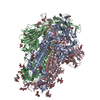
 要素
要素
 Homo sapiens (ヒト) / 参照: UniProt: P0DTC2
Homo sapiens (ヒト) / 参照: UniProt: P0DTC2 試料調製
試料調製
 Homo sapiens (ヒト) / 細胞: Expi293 / プラスミド: pCDNA3.1
Homo sapiens (ヒト) / 細胞: Expi293 / プラスミド: pCDNA3.1 電子顕微鏡撮影
電子顕微鏡撮影
 FIELD EMISSION GUN / 加速電圧: 300 kV / 照射モード: FLOOD BEAM
FIELD EMISSION GUN / 加速電圧: 300 kV / 照射モード: FLOOD BEAM 解析
解析 ムービー
ムービー コントローラー
コントローラー














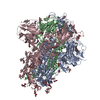


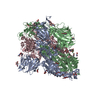
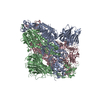
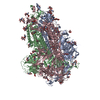
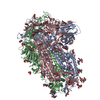
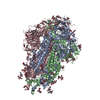

 PDBj
PDBj






